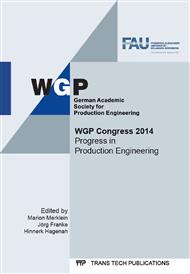[1]
J.M. Yusta, F. Torres, and H.M. Khodr, Optimal Methodology for a Machining Process Scheduling in Spot Electricity Markets, Energy Conversion and Management Vol. 51/12 (2010) 2647–2654.
DOI: 10.1016/j.enconman.2010.05.030
Google Scholar
[2]
W. Eversheim, Produktionstechnik und -verfahren, in W. Kern et al. (Eds. ), Handwörterbuch der Produktionswirtschaft, Schaefer-Poeschel-Verlag, Stuttgart, 1996, p.1534–1544.
Google Scholar
[3]
M. Grassl, E. Vikdahl, G. Reinhart, A Petri-Net based Approach for Evaluating Energy Flexibility of Production Machines, in M.F. Zaeh (Ed. ), Enabling Manufacturing Competitiveness and Economic Sustainability, Springer International Publishing, 2014, p.303.
DOI: 10.1007/978-3-319-02054-9_51
Google Scholar
[4]
A. Pechmann, I. Schöler, Optimizing Energy Costs by intelligent Production Scheduling, in J. Hesselbach and C. Herrmann (Eds. ), Glocalized Solutions for Sustainability in Manufacturing, Proceedings of the 18th CIRP International Conference on Life Cycle Engineering, Springer, Berlin, 2011, p.293.
DOI: 10.1007/978-3-642-19692-8_51
Google Scholar
[5]
R. Popp, M.F. Zaeh, Steuerung des Energiebedarfs von Werkzeugmaschinen, wt Werkstattstechnik online 104 H7/8 (2014), submitted.
DOI: 10.37544/1436-4980-2014-6-413
Google Scholar
[6]
VDI4602 – Energy Management – Terms and Definitions (2007).
Google Scholar
[7]
S. Hirzel, B. Sontag, C. Rohde, Betriebliches Energiemanagement in der industriellen Produktion, Fraunhofer ISI, Karlsruhe, (2011).
Google Scholar
[8]
E. Müller, R. Hiersemann, PEACH – Projektierung und Steuerung energieeffizienter Anlagen, in E. Müller et B. Spanner-Ulmer (Eds. ), Wissenschaftliche Schriftenreihe des Institutes für Betriebswissenschaften und Fabriksysteme, Chemnitz, (2010).
Google Scholar
[9]
N. Weinert, Vorgehensweise für Planung und Betrieb energieeffizienter Produktionssysteme, Dissertation Technische Universität Berlin, Fraunhofer Verlag, Stuttgart, (2010).
Google Scholar
[10]
W. Schöfberger, Abschaltbare Fabrik – Zentrale Leittechnik und Gesamtkonzept zu Energieeinsparungen und zur Ressourcenoptimierung im Standby Betrieb von Industrieanlagen, Vienna, (2010).
Google Scholar
[11]
A. Verl, E. Westkämper, E. Abele, A. Dietmair, J. Schlechtendahl, J. Friedrich, H. Haag, S. Schrems, Architecture for Multilevel Monitoring and Control of Energy Consumption, in J. Hesselbach and C. Herrmann (Eds. ), Glocalized Solutions for Sustainability in Manufacturing, Proceedings of the 18th CIRP International Conference on Life Cycle Engineering, Springer, Berlin, 2011, p.347.
DOI: 10.1007/978-3-642-19692-8_60
Google Scholar
[12]
B. Denkena, T. Garber, NCplus Prozess- und wertschöpfungsorientiert gesteuerte Werkzeugmaschine, PZH-Verlag, Garbsen, (2013).
Google Scholar
[13]
A. Dietmair, A. Verl, Energy Consumption Forecasting and Optimisation for Tool Machines, MM Science Journal 3 (2009) 62–67.
DOI: 10.17973/mmsj.2009_03_20090305
Google Scholar
[14]
B. Kuhrke, Methode zur Energie- und Medienbedarfsbewertung spanender Werkzeugmaschinen, Dissertation Technische Universität Darmstadt, epubli, Berlin, (2011).
Google Scholar
[15]
E. Abele, M. Dittrich, C. Eisele, O. Kessling, W. Klöben, M. Rudolph, W. Rummel, Energieeffiziente Produktionsmaschinen durch Simulation in der Produktentwicklung, Ergebnisbericht des BMBF Verbundprojektes eSimPro, Darmstadt, (2013).
DOI: 10.3139/104.110431
Google Scholar
[16]
A. Zein, Transition Towards Energy Efficient Machine Tools, Springer, Berlin, (2012).
Google Scholar
[17]
T. Gutowski, J. Dahmus, A. Thiriez, Electrical Energy Requirements for Manufacturing Processes, 13th CIRP International Conference on Life Cycle Engineering, Lueven, (2006).
Google Scholar


